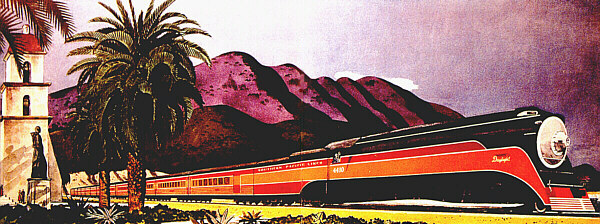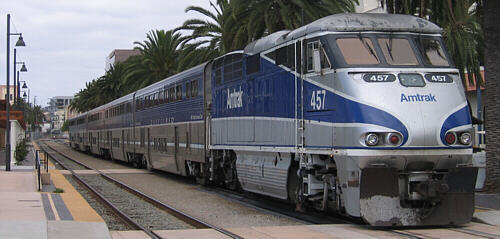 The Monterey Peninsula Toy Box |
Coming to Monterey County Salinas
Commuter Service
|
|
|
|
||
7
Salinas Commuter Service
At present, the only passenger rail service to Monterey County is provided by Amtrak's Coast Starlight, an interstate train that makes a stop in Salinas on its daily run between Los Angeles and Seattle. For much of the last decade, the Transportation Agency for Monterey County (TAMC) has been working to bring additional trains to Salinas, particularly to serve the commuter market to the San Francisco Bay Area.Until 2009, TAMC was assuming this service would be provided by Caltrain, which currently serves the San Francisco-Gilroy market. It was thought that the short extension to Salinas would be a fairly simple matter. However, there was no formal agreement, and Caltrain's governing board ultimately decided the plan did not fit their long-term goals, particularly in regards to plans to convert from diesel to electric locomotives which would not be able to operate south of San Jose.
More recently, TAMC has been in discussion with the Capitol Corridor Joint Powers Authority (CCJPA) which manages a highly successful rail corridor extending from San Jose to Sacramento and beyond. The CCJPA has expressed an interest in providing Salinas service, but has also made it clear that because the Salinas extension would go beyond the CCJPA's formal boundaries, TAMC would be responsible for all capital and operating costs relating to the extension. Since the CCJPA is short on rolling stock, TAMC may have to purchase one or two entire trainsets, a tall order in this economic downturn.Still, this is a positive development. The Capitol Corridor provides significantly more comfortable cars than Caltrain, and even provides a cafe car for food service on board. Other amenities include electrical outlets for laptops, wi-fi service, and tables for social seating.
As currently envisioned, this service is primarily intended to serve commuters shuttling between homes in our area to jobs in the bay area, with the intent of taking some of the traffic off of Highway 101. Thus the trains will likely operate northbound in the morning, and southbound in the evening, with the trains laying over in Salinas overnight. Travelers destined for cities on the San Francisco peninsula may easily transfer to Caltrain at San Jose.
Alas, Monterey County residents probably won't be able to enjoy the all-day-long service available to our northerly neighbors on the Capitol Corridor, but then, we don't have the same population density they do, so we'll be grateful for what we can get. However, this midday void may be partially filled by the revival of the Coast Daylight (see below).
To accommodate the new service, plans are also being developed for an extensive rehabilitation of the Salinas Amtrak station. Plans call for an "Intermodal Transit Center" to be developed on the site to provide seamless transfers between the trains, Monterey-Salinas Transit buses, and other bus services. In addition, a large parking lot or a parking structure will provide up to 700 spaces to serve the "park & ride" crowd. TAMC has taken care to ensure that existing historic structures on the property, including the station building, a 19th century freight depot, a historic locomotive display, and other structures are preserved and properly utilized. The passenger platform will receive a much needed modernization. A layover facility will be constructed for overnight parking of the trains.
The trains will also make stops at Castroville and Pajaro, where new station facilities will be constructed..
Naturally, it will take some time to get all of this together, what with studies, agreements between various agencies and Union Pacific, and all that. So service is not scheduled to begin before 2013. Expect delays due to inevitable funding shortfalls that seem to be routine these days.
Complete details can be found on the official TAMC Rail Program site. You can download the environmental impact report there, and study its details at your leisure.
The Coast Daylight
Southern Pacific’s original Daylight, which connected Los Angeles with San Francisco, was one of most heavily traveled trains in the nation. Renamed the Coast Daylight in 1952, it last ran in 1971 when Amtrak combined the line with other west coast routes to create the Coast Starlight. The Starlight is now routed through Oakland requiring a shuttle bus to take passengers into San Francisco.
Today the Coast Starlight is operating at capacity between Los Angeles and the Bay Area. An additional Amtrak train is needed to keep up with demand. Considered a high priority, Amtrak and Caltrans were looking to start the revived LA to SF Coast Daylight way back in 2001. However, state budget cuts that year put start-up funding on hold indefinitely. The most hopeful estimate is that service might start in 2012.
Once in place, the revitalized Coast Daylight, like the Coast Starlight, will stop in Salinas. Unlike the Starlight it will also stop in Gilroy, Pajaro and King City. A stop in Soledad is also likely. Shuttle services will be available in Millbrae to take passengers to and from the San Francisco airport. If they do it right, timely connections should be available for passengers to transfer to and from Capitol Corridor trains, opening up rail travel opportunities from Monterey County to east bay cities and Sacramento. This could help fill the void caused by the perpetual delays of the Del Monte revival.
The Coast Daylight would likely run about two hours earlier than the Coast Starlight. A proposed timetable is available here, along with a sample Starlight timetable for comparison. As currently envisioned, one train would depart San Francisco and another would depart Los Angeles each morning, and each would arrive at their final destinations around 7:00pm. However, this is subject to change. Due to track conditions, initial travel time for the length of the run will be about 12 hours. (In the 1950s SP was able to run it in 10 hours, which shows you how much things have deteriorated since then.) However, planned track and equipment upgrades should eventually reduce that time to about 8 hours. Whether that will happen in our lifetime is an unknown. A lot depends on the political will to fund rail.

A Surfliner trainset, seen here in San Diego
Most likely the revived Daylight will utilize bi-level Surfliner cars, which are used in the heavily traveled Surfliner Corridor between San Diego and San Luis Obispo.
Planning for the Daylight is being done by a group called the Coast Rail Coordinating Council.
|
|

